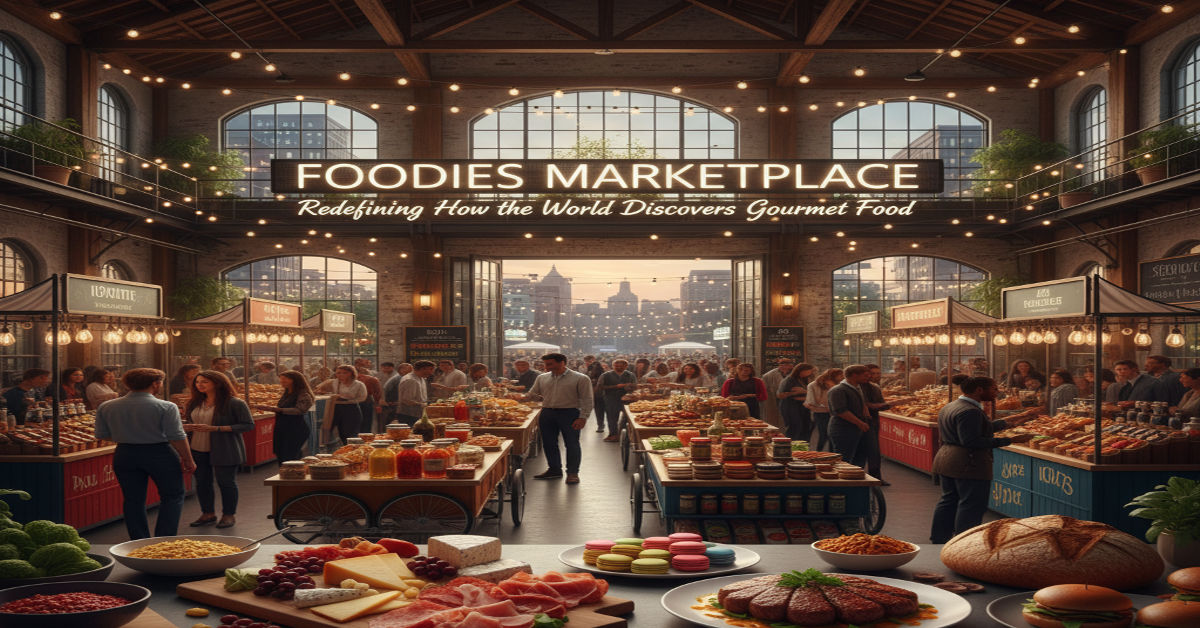In recent years, there has been a noticeable shift in how people buy and experience food. Shoppers are no longer satisfied with mass-produced groceries that lack character or story. They crave authenticity, freshness and uniqueness. This desire for meaningful culinary experiences has given birth to the foodies marketplace — a dynamic platform where discovery meets quality.
The foodies marketplace model bridges the gap between passionate eaters and remarkable food makers. It gives consumers access to imported, small-batch and artisanal products that are often impossible to find in regular stores. For businesses, it opens a direct channel to food enthusiasts who value originality over convenience.
This transformation in the food industry signals not just a trend but a new consumer era driven by passion, exploration and trust.
Understanding What a Foodies Marketplace Truly Is
A foodies marketplace is not just another e-commerce platform selling groceries. It’s an ecosystem that curates, celebrates, and connects. It brings together specialty food producers, importers, and customers who share one thing in common — a love for good food.
Such a marketplace emphasizes discovery over volume. It prioritizes stories behind products, transparency in sourcing, and access to foods that elevate the everyday dining experience. Unlike standard supermarkets, the focus lies in the curated mix of flavors and experiences.
To visualize this distinction, consider the table below, which contrasts the identity of a foodies marketplace with that of conventional grocery retail.
| Aspect | Foodies Marketplace | Traditional Retail Store | Key Takeaway |
| Core Concept | Experience-driven and curated | Volume and accessibility-focused | Marketplace emphasizes story and exclusivity |
| Product Range | Imported, niche, and artisanal | Common brands and everyday goods | Uniqueness becomes a selling point |
| Consumer Base | Food enthusiasts, explorers, chefs | General public, mass buyers | Targeted, loyal audience |
| Pricing Strategy | Premium for authenticity | Competitive pricing | Value lies in experience, not just cost |
| Relationship Model | Direct-to-consumer and community-based | Transactional | Built on trust and storytelling |
This distinction shows why these platforms have gained traction among younger generations who seek more than just convenience.
The Evolution of Gourmet Commerce
Food commerce has evolved dramatically. The old model of supply and demand has been replaced by a hunger for connection and culture. Consumers now want to know where their food comes from and how it’s made. This evolution has been driven by technology, logistics, and shifting values.
In earlier years, food was mostly local and functional. As global trade expanded, international ingredients became accessible, but most were still filtered through large distributors. Today, the digital era has created a bridge between producers and eaters. That bridge is the modern foodies marketplace — agile, transparent, and globally connected.
The pandemic further accelerated this shift. People turned to online platforms not only for essentials but for indulgence and joy. Buying gourmet olive oil or imported cheese online became an act of self-care rather than luxury. That behavioral change made marketplaces specializing in unique food items thrive.
Direct Imports and the B2C Advantage
At the heart of the best foodies marketplaces is a business-to-consumer model supported by direct imports. This structure ensures authenticity and price control while maintaining high product standards. It cuts out unnecessary intermediaries, allowing the platform to source products that often don’t exist elsewhere in the region.
The B2C and direct import approach also allows for more intimate storytelling. When a product reaches a customer, the marketplace knows its origin, the producer’s methods, and the quality checks involved. Consumers, in turn, get more than a product; they get an experience.
To understand the operational benefits of this system, the following table provides a detailed view of how direct import improves value delivery.
| Process Area | Traditional Distribution | Direct Import through Foodies Marketplace | Impact |
| Sourcing | Handled by multiple intermediaries | Managed directly with producers | Lower cost, higher control |
| Product Authenticity | Hard to verify | Verified through direct relationship | Greater transparency |
| Inventory Speed | Slower, dependent on wholesalers | Faster restocking cycle | Better freshness |
| Consumer Communication | Limited to product label | Enhanced through digital storytelling | Builds loyalty |
| Exclusive Offerings | Minimal | High — often unavailable elsewhere | Creates brand identity |
This model gives consumers access to a curated experience and provides suppliers with global visibility without needing their own distribution network.
Inside the Operations of a Foodies Marketplace
Behind every successful foodies marketplace lies a precise operational structure that ensures freshness, variety, and reliability. It starts with supplier vetting, where producers are evaluated for quality certifications, ethical sourcing, and consistency. Once approved, their products are cataloged, photographed, and presented with compelling descriptions.
Inventory management plays a central role, particularly for perishable or temperature-sensitive products. Most marketplaces combine local warehousing with just-in-time delivery to minimize waste. Packaging is customized for product type — vacuum-sealed for meats, insulated for cheeses, and eco-friendly for shelf-stable goods.
Customer service ties it all together. The marketplace must handle queries, ensure transparent delivery tracking, and manage returns with care. Success depends on balancing efficiency with human touch, ensuring that the buyer feels valued and informed at every step.
Why Consumers Are Drawn to Specialty Marketplaces
Food is emotional. A meal can connect people to places, memories, and emotions. Foodies marketplaces tap into this emotional layer by offering not just products but experiences. For consumers, each purchase is a discovery — a chance to try something unique or connect to another culture.
They also provide trust in curation. Customers know the platform has done the hard work of sourcing and quality checking, which builds loyalty. Moreover, the storytelling aspect — photos, blogs, recipes — transforms buying into an exploration.
Below is a creative table summarizing key consumer motivations that make these marketplaces successful.
| Motivation | Description | Example Experience | Emotional Trigger |
| Exploration | Desire to try global and new flavors | Sampling a spice blend from North Africa | Curiosity and adventure |
| Connection | Feeling part of a global food community | Reading producer stories | Cultural appreciation |
| Authenticity | Confidence in genuine products | Buying real Italian truffle oil | Trust and satisfaction |
| Convenience | Easy access to global ingredients | One-stop online purchase | Relief and comfort |
| Learning | Expanding cooking knowledge | Watching recipe videos | Empowerment and creativity |
This emotional connection sets foodies marketplaces apart from regular food retailers.
The Opportunity for Artisans and Niche Producers
Small food producers often struggle to compete with large brands due to distribution and marketing limitations. A foodies marketplace opens doors for these artisans to reach global audiences without heavy infrastructure costs.
Through this platform, they can showcase their craft, share their stories, and maintain brand integrity. The marketplace provides the logistics, digital storefront, and marketing tools they need. For many artisans, this partnership transforms their local specialty into a sustainable business.
The relationship between producer and platform creates a win-win scenario. Producers focus on quality, while the marketplace manages operations, customer engagement, and data insights that guide future growth.
Challenges Behind the Scenes
Even with an inspiring mission, running a foodies marketplace isn’t without its challenges. The complexities of importing perishable items, managing international suppliers and maintaining consistent standards can be daunting.
Supply chain disruptions, temperature control issues, and customs delays can affect delivery schedules. Managing expectations in such cases requires clear communication and strong customer service policies.
There’s also the issue of regulation. Every country has its own food safety requirements and labeling standards. A strong marketplace must navigate these seamlessly while protecting both the brand and the consumer. Building resilience in this space demands careful planning, strong partnerships, and continuous innovation.
Key Drivers of Success
A thriving foodies marketplace is built on trust, quality, and creativity. The ability to curate rather than just sell is what keeps customers returning. Success depends on supplier integrity, clear product presentation, and efficient delivery.
Community engagement is also vital. Encouraging user reviews, hosting food-related events, and creating educational content help maintain interest. Consumers stay connected when they feel part of something larger — a shared journey of taste and discovery.
The following table outlines the essential performance indicators that signal success in this evolving business model.
| Metric | Description | Why It Matters | Recommended Benchmark |
| Average Order Value | The average spend per customer per transaction | Indicates upsell effectiveness | $50–$80 for gourmet marketplaces |
| Repeat Purchase Rate | Percentage of returning customers | Reflects loyalty and satisfaction | Over 40% considered strong |
| Delivery Accuracy | Orders fulfilled correctly and on time | Ensures service reliability | 98% or higher |
| Spoilage Rate | Percentage of goods wasted or damaged | Impacts profit margin | Below 3% ideal |
| Customer Review Score | Average rating across all products | Reflects trust and brand image | Above 4.6 preferred |
Tracking these numbers ensures continuous improvement and helps maintain a high-quality reputation.
Understanding the Market Landscape
The global specialty food sector has expanded rapidly as consumers seek novelty and quality over quantity. According to global market data, demand for imported and premium foods continues to rise yearly, with regions in Asia and the Middle East leading growth in gourmet imports.
Technology has played a major role, with online grocery platforms evolving into lifestyle ecosystems. Consumers now rely on these platforms not only for shopping but also for culinary inspiration, recipes, and cultural exchange.
Investors are increasingly recognizing the value of curated food platforms. The model offers higher margins than regular grocery retail and attracts a loyal, high-spending audience that appreciates authenticity. As competition grows, differentiation through storytelling and exclusivity remains the defining edge.
Case Studies and Real-World Insights
To see the foodies marketplace in action, consider how niche platforms around the world are evolving. In Singapore, one marketplace focuses on directly importing fine meats and cheeses. In Europe, another specializes in farm-to-table organic produce, building relationships with small farmers. In the United States, subscription-based marketplaces are offering rotating selections of global products each month.
Each version adapts to its audience while maintaining the same foundation: direct sourcing, strong storytelling, and community-driven branding. Successful marketplaces find balance — between exclusivity and accessibility, between premium pricing and everyday delight.
These examples reveal that authenticity, coupled with operational precision, creates not just profit but long-term trust.
Marketing and SEO Growth Strategies
To stand out, a foodies marketplace must approach marketing creatively. Traditional advertising alone isn’t enough. A content-driven strategy works best, blending education and engagement. Blogs, recipe tutorials, and chef collaborations help position the brand as a trusted authority.
Search engine optimization plays a huge role. The keyword foodies marketplace should appear naturally in the content and metadata. Long-tail phrases such as artisan food marketplace or imported gourmet store can help attract niche traffic.
Partnerships with food influencers can expand visibility. Hosting virtual tastings or live-streamed cooking sessions builds emotional engagement. Regular newsletters featuring exclusive product launches keep customers returning.
The goal is not just traffic but meaningful interaction. A well-told food story can turn a single visitor into a lifelong advocate.
Conclusion and Future Outlook
The foodies marketplace represents more than commerce; it is a cultural movement built around discovery and trust. It connects small producers with curious consumers, creating an ecosystem that celebrates quality and authenticity.
As logistics and technology improve, these marketplaces will only grow stronger. Artificial intelligence can enhance product recommendations while blockchain can verify product origins. Yet, the heart of the model remains human — the joy of sharing great food and the stories behind it.
For entrepreneurs, this is a space filled with opportunity. For consumers, it’s a chance to taste the world from home. The future of food retail lies not in volume but in value, and foodies marketplaces are leading the way toward that future.
FAQs
Q1. What makes a foodies marketplace different from a typical online grocery store?
A foodies marketplace focuses on curated, high-quality and often imported items. It emphasizes storytelling, authenticity and exclusivity rather than selling mass-market products.
Q2. How do these marketplaces maintain product freshness?
They use advanced cold chain logistics, vacuum-sealed packaging, and just-in-time inventory models to ensure quality during shipping and storage.
Q3. Can small producers easily join such platforms?
Yes. Most marketplaces have onboarding programs for artisans and small businesses, helping them with compliance, packaging, and logistics while offering a wider audience.
Q4. What are the main risks involved in running a foodies marketplace?
Supply chain disruptions, regulatory compliance, and spoilage risks are major challenges. Clear processes, reliable partners, and insurance coverage can mitigate these issues.
Q5. How can a new marketplace attract its first customers?
Start with a niche focus, tell powerful product stories, collaborate with chefs or influencers, and build an email list through engaging content and limited-time offers.







